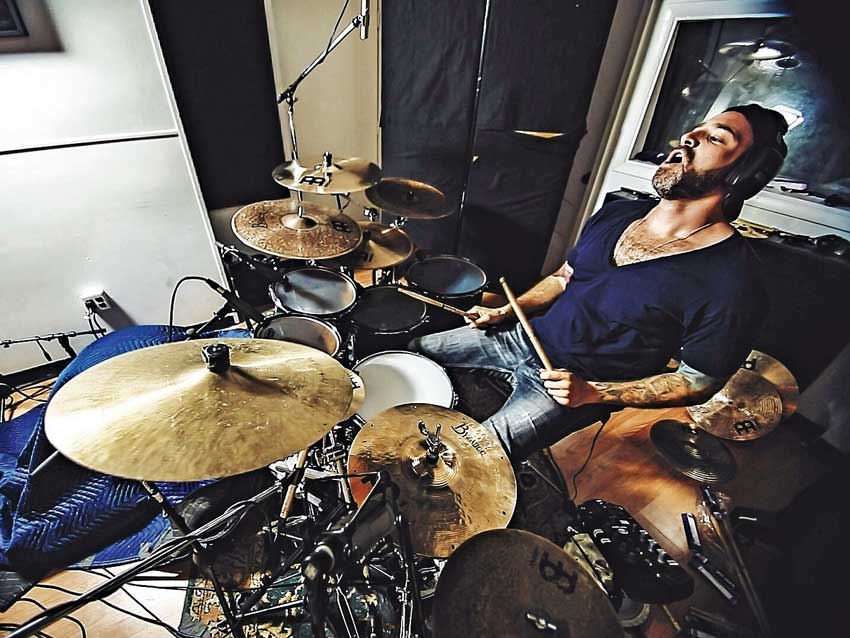Periphery's guide to recording drums
How Matt Halpern achieved his Juggernaut drum sound

Juggernaut: Alpha & Omega
As the band release their two-album opus, Juggernaut: Alpha and Juggernaut: Omega, Periphery’s own prog drumming juggernaut Matt Halpern and bass player/producer Nolly Getgood talk through the processes behind getting Matt’s drum sound. Here they break down four of the band’s key tracks from the albums, and talk about Matt’s wicked new Wraith snare.

'22 Faces'
How did the drum part come about?
Matt: “It came together over time based on the way the arrangement of the song developed. This was actually a song that took many iterations before we were happy, and changed a lot over the course of well over a year. By the time we hit the studio I had a really clear picture of how I wanted it to come out and it was really just a case of making sure we didn’t miss any accents – the song has so many specific parts that needed to be perfect so we had to keep our eye on the ball at all times.”
How was the drum sound developed at the recording stage?
Matt: “For this track I envisaged a tight, cracky snare sound with loads of punch. My snare has a really wide tuning range so we were able to crank it fairly tight without losing body.”
Nolly: “This song has a lot of double kick so it was important to get a lot of attack out of the drum. Matt has very powerful footwork, and we took the time to make sure that the final takes all had the tightest, most consistent hits so the intensity never dips.”
Production tips from recording the track?
Nolly: “When working with higher-tuned snares, I find I end up using a lot of the room mics and even artificial reverb in the mix in order to get across the power of the sound in the room.”

'Psychosphere'
How did the drum part come about for the track ‘Psychosphere’?
Matt: “As with all of the songs on the record, I really tried to pay attention to the meaning and vibe of the song. In this case it’s a slow, powerful riff with a lot of space so I didn’t want to overcrowd things with busy parts.”
How was the drum sound developed at the recording stage?
MH: “We went with fairly low-tuned drums to get a powerful sound that would carry the slow tempo. I also used larger crashes than on most songs, so they’d be more about sustain and wash than tight attack.”
Production tips from recording the track?
Nolly: “Knowing how to use compression is a key part of achieving power from your drum mixes. Try using compression settings with a slow attack time and fast release to emphasise the impact of the stick hitting each drum.”

'The Bad Thing'
How did the drum part come about?
Matt: “For this song we had a really heavy groove and killer vocal melody that we wanted
to utilise as a chorus, so we wrote the whole song around that part. At the start of the song, the groove is fairly sparse and spacious, but through the song I build it up with a lot more detailed parts to keep the energy ramping up towards the song’s climax.”
How was the drum sound developed at the recording stage?
Matt: “We knew the drums needed to be very powerful and aggressive. We were really excited to use the Wraith snare for this song because it’s got a great aggressive character even when tuned low.”
Nolly: “From the engineering and mixing perspective, I wanted to really focus on the bottom end of the drums, making sure they punched hard in the bass area especially on the kick and toms. The mid section build-up is a good example of the low-end power of the tom sound on the album.”
Production tips from recording the track?
Nolly: “When mixing drums, EQ’ing out mid-range can increase the perceived depth of sound of the drum. Sometimes that can be a lot more effective than trying to boost the bass instead.”

'Stranger Things'
How did the drum part come about?
Matt: “When we demoed ‘Stranger Things’ out as a band, the middle section immediately inspired me to come up with an ostinato-based groove that could build through the section, using various accent cymbals to keep interest. It’s one of the parts on the album where the drums get to take centre stage and drive the section while the guitars take a more textural role.”
How was the drum sound developed at the recording stage?
Matt: “This song is epic in nature, and it was clear the drums needed to have a massive ambience to close the album out the right way.”
Nolly: “Despite the density of the song, there is quite a lot of intricate drumming going on throughout, so my attention was on making sure every part of Matt’s kit had the necessary clarity so the listener could be fully immersed in his playing.”
Production tips from recording the track?
Nolly: “If you have enough inputs, cover yourself by close-miking the hi-hats, ride and accent cymbals. You don’t have to use these tracks if they aren’t needed, but you can use them to add detail and punch to any intricate parts you may have recorded.”

Matt's Wraith
How did you first get involved with designing your own snare drum with Mapex?
“I initially approached Mapex about the development and design of this drum. It’s something I’ve wanted to do for a long time. It was a great experience. I learned a ton and was able to build a much stronger relationship with my friends at Mapex.
“I knew I wanted brass, and I knew I wanted a bit of venting. The size was also something I was very set on. The goal was to have a versatile and lively drum.
“The snare is definitely supposed to be multi-purpose and is very flexible for different situations – live and in the studio. It should be a new ‘go-to’ drum for producers and drummers alike!”

Want more?
Periphery’s Matt Halpern and Misha Mansoor go track by track through the Juggernaut albums on MusicRadar, and you can read the full interview with Matt and Nolly on the recording of Alpha and Omega in Rhythm’s March issue, in print and digitally from iTunes!